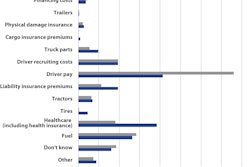The Tax Cuts and Jobs Act enacted in late 2017 was mostly beneficial to trucking industry stakeholders. In addition to cutting rates for corporations and smaller pass-through entity businesses, the law overhauled personal tax filings, too, allowing larger standard deductions for all filers and lowering rates across the board.
However, swept away with the old tax code was the allowance for transportation workers — such as truck drivers — to take an income deduction for daily expenses on meals and incidentals, aka the per diem deduction. The change only affects company drivers, as owner-operators will still file their per diem as businesses expenses.
Until the 2018 tax year (filings for which are due April 2019), drivers could deduct from their annual income 80 percent of the allowed $63 for every day spent away from home. Often, that amounted to a hefty deduction and could save drivers thousands a year in tax liability. For instance, a driver on the road four days a week could take a deduction of nearly $10,500. A driver on the road five days a week could deduct more than $13,100. Depending on the driver’s income, those deductions alone could knock $1,500 or more off of a driver’s annual tax bill.
Though many carriers are aware of this change, which will be reflected for the first time this year on annual tax returns, many drivers aren’t aware, says Kehl Carter, CEO of Atlantic HR Solutions, a consulting firm that works with hundreds of carriers nationwide.
He recently polled 400 drivers at a major fleet that operates more than 5,000 trucks. “Of those 400, only three or four knew that the law had been changed,” he said. “That’s a pretty good test,” he says, showing that many drivers will likely be caught by surprise when they file their taxes this year.
Since last January, when the change took effect, some carriers have sought to alter their driver compensation packages to help account for the bygone per diem deduction, either by factoring per diem pay into drivers’ per-mile pay or by paying the actual $63 (now $66 in 2019) per diem to drivers for the days spent on the road. That means drivers receive a lower base pay, but they’ll benefit from the tax-free per diem reimbursement. Again, the 80 percent rate applies, so $50.40 of last year’s $63 per diem would be tax free under those restructured pay plans.
Likewise, carriers avoid paying items like payroll taxes and worker’s comp on those reimbursements.
Carter says there’s a pronounced trend among carriers to shift to a pay model that includes per diem compensation. “It’s a huge movement right now for retention and recruiting,” he says. “Because of the driver shortage, you don’t want to be the carrier that doesn’t offer drivers an alternative. We know a driver will leave an employer” for even a small bonus, says Carter, “let alone something that could be [worth] $4,000” or more annually.
The larger standard personal deductions instituted by the 2017 law will somewhat offset the effects of the removal of the per diem deduction. Married couples now take a standard deduction of up to $24,000, nearly double that of the previous $12,700. Single filers also got a boost in the standard deduction — now $12,000, up from the previous $6,350.
Kevin Rutherford, a former small fleet owner and now a radio personality and owner-operator coach, said early last year he estimated that company drivers would pay on average $600 or more a year in taxes due to the loss of the per diem allowance.
Like Carter, Rutherford said the onus would be on carriers to overhaul their pay plans to account for the change. As an example, he said drivers who were making 40 cents a mile could take a base pay of 30 cents a mile and then have a 10 cents a mile added as a per diem reimbursement.
However, Carter noted that the per-mile structure may be limited in its ability to fully account for the per diem reimbursement. He suggests that carriers track the number of days drivers spend on the road and multiply that by the per diem rate allowance.
All that’s needed to track per diem reimbursements are the time, day and location of when a driver “had a meal or should have had a meal or could have had a meal,” he said.













